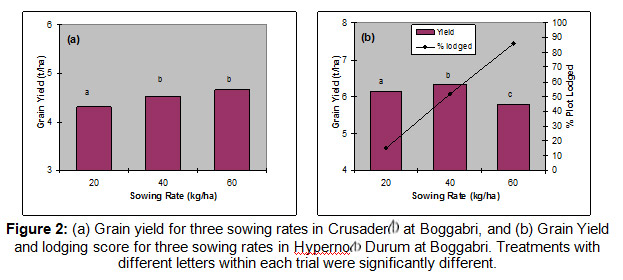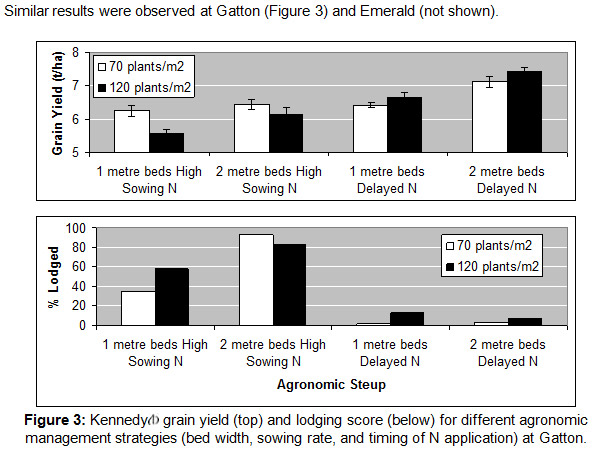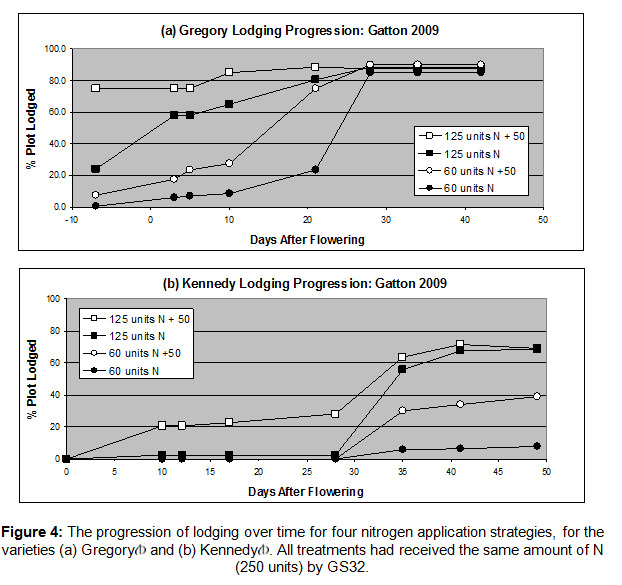IMPROVING YIELDS IN IRRIGATED WHEAT: 2009 TRIAL UPDATE
| Date: 21 Sep 2010

Introduction
The Achievable Yields project is aiming to set yield and water use benchmarks for irrigated wheat in the northern region, while also helping growers address the main agronomic challenges that prevent them from maximising grain yield. Following the widespread lodging in 2008, a number of on-farm trials were run in 2009 to assess the best agronomic strategies to decrease lodging risk. The findings from these experiments are reported here, along with some preliminary yield and water use benchmarks for irrigated wheat.
A brief recap on the causes of lodging
The experiences of the 2008 irrigated wheat season were reported on at the Goondiwindi update in 2009 (Peake and Angus, 2009). In that paper a full summary of the agronomic issues that cause lodging were discussed at length (a link is available in the reference section at the end of this paper). To briefly recap, lodging is caused by weakened stems and decreased root anchorage, which are both caused by excessive shading within the canopy in the early stages of the crop.
Reducing sowing rate for lodging control: 2009 trials
In 2008, very high seeding rates of 200+ seeds/m2 were used in many locations for irrigated wheat (or approximately 80kg/ha of seed or higher). Sometimes this occurred on bed configurations where the seed was concentrated in a 40-50cm wide band on top of 1m beds, which meant that the effective rate was 400+ seeds/ m2 (160+ kg/ha seed) on top of the bed. Aware that reduced plant populations might decrease lodging risk without affecting yield, we experimented with sowing rates at Boggabri, St George, Gatton and Emerald. Unfortunately the dry season meant that the St George trial only received one irrigation and yielded around 2.2 t/ha with no detectable difference between seeding rates of 15-80 kg/ha.
At Boggabri, seeding rates of 20, 40 and 60 kg/ha were tested in a paddock of Crusader , and also a paddock of Durum (Hyperno ). Both paddocks had more than 200 units of N in the profile at sowing, and received three in-crop waters after starting on a full profile. The crop lodged on the last watering shortly after flowering, and the results are displayed in Figure 2.
The paddock of Crusader (Figure 2a) had lower yield potential due to some disease issues, and irrigation scheduling was sub-optimal. Ultimately no lodging was experienced as yield potential was not high. Yield increased slightly with sowing rate, but no statistically significant difference was detected between the 20 and 40 kg/ha sowing rates.
The paddock of Hyperno (Figure 2b) was a very healthy crop, and it lodged on the last watering just after flowering. There were clear differences between the degree of lodging that occurred between the sowing rates with lodging getting worse with higher plant populations (Figure 2b). The severity of lodging in the 60 kg/ha treatment (Figure 2b) was probably the cause of reduced yield in that treatment. The bed configuration at this site (with 80cm wide furrow-gaps) was such that the sowing rate on top of the bed in this treatment was more like 100 kg/ha, even though the growers sowing rate was 60 kg/ha of seed across the paddock.

At Gatton, emergence rates of 70 and 120 plants/m2 were achieved from 27 and 55kg/ha of seed. Interestingly, 120 plants/m2 yielded less than 70 plants/m2 in the worst lodged sections of the trial (Figure 3) where more soil N was available at sowing. Yet in the delayed N treatment where only 60 units of soil N were available at sowing (to 180cm below the surface), the opposite occurred. Sowing Kennedy at 27 kg/ha (70 plants/m2) was not sufficient to maximise yield in this treatment, and 120 plants/m2 had the highest yield.
So what is the take home message in regards to plant population? Irrigated wheat appears to have a similar optimum planting rate to dryland: around 40kg/ha (100 plants/m2), possibly lower if the seed is going to be concentrated on top of a bed with large furrow gaps between beds. Planting higher rates than this will increase lodging susceptibility and could cause yield loss if it induces greater rates of lodging. Obviously each grower needs to consider planting conditions, seed size and seed quality into account when finalising their sowing rate. Sowing date also influences the sowing rate, as earlier sown crops tiller more heavily and don’t require as much seed, while late sown crops tend to tiller less and may need a higher sowing rate to boost yield potential.
Slightly higher rates (up to 60kg/ha or 150 plants/m2) may be more appropriate in overhead irrigated paddocks where there is no furrow gap and the plants are distributed better across the paddock. The slightly higher rate may also be beneficial in paddocks where a deliberate lodging reduction strategy (such as delayed N application) will be used.
Delayed N application trials
In 2008, a soil survey of 12 paddocks across the northern region revealed that excessively high levels of N were present at the beginning of that season. High levels of N were identified as one of the contributing factors leading to the lodging issues in 2008, and delayed application of N is a strategy used in southern Australia to control lodging and achieve high grain yield (Angus & Lacy, 2002).
The aim of delaying N application is to heavily stress the crop by GS31-GS32, reducing leaf production in the crop. This in turn reduces shading at the base of the plant. The extra sunlight strengthens stems and increases the length of the surface structural roots, reducing the risk of both stem and root lodging.
At an intensive small plot trial at Gatton, the progression of lodging over time was recorded for different nitrogen application strategies. We created a paddock with two different soil nitrogen levels at sowing; 125 and 60 kg/ha of N (measured to a depth of 180cm). In addition we added 50 units of N at sowing to some plots in both the high and low soil N areas, to create four N levels. At GS32, all treatments were side dressed with an amount of N so that each plot had about 250 kg/ha of N made available to them through the season to that point. For instance, the 125 kg/ha of N area received another 125 kg/ha of N at GS32, while the 60 kg/ha of N area received a further 190 kg/ha of N at GS32. All plots therefore had 250 units of N as pre-plant soil N or added urea, by GS32. At anthesis a further 50 units of N was applied to all plots.
Two varieties were used for the trial, EGA Gregory and Kennedy . Both were planted in the middle of their respective planting windows, so Kennedy was sown three weeks later than the Gregory , and ended up flowering a week later. The aim was to try and achieve simultaneous flowering and expose them both to identical lodging events at similar physiological stages, and the same weather conditions during flowering and grain filling. No frost events occurred near flowering, or during grain filling.
From flag leaf until harvest, five potential lodging events were applied to the experiment (as a 40mm irrigation applied with hand shift spray lines), and a sixth potential lodging event was also experienced as 30mm of rainfall in a storm. The progression of lodging is recorded in Figures 4a and 4b. Note that the lodging all tended to be root lodging in this trial, with the surface roots on one side of the plant lifting out of the soil as the plants toppled over.
Within the Gregory plots (Figure 4a), it is clear that the treatments with greater N at sowing lodged more quickly, but ultimately all treatments were heavily lodged. In comparison, the Kennedy section of the trial (Figure 4b) did not lodge as badly, and the delayed N section of the Kennedy trial had very little lodging by the end of the season, while still experiencing the highest yield of all sections of the trial (Table 1).

So the ‘take home message’ here is that successful delayed N application can reduce your lodging risk quite substantially, but may not be enough to stop lodging in a later maturing, tall statured variety such as Gregory . Very low sowing N levels are necessary to achieve minimal lodging and maximum yield: around 60 units of soil mineral N was present at sowing in the best yielding treatments, to a depth of 180cm. Many commercial soil testing operations only test to 90cm – and this section of the paddock only had 40 units of N down to 90cm.
There is some risk however, as to how well N can be applied and incorporated after sowing in a commercial operation. The concern specific to our region is that our clay soils take a long time to dry out in winter, so a badly timed rain event could prevent access to the field and delay N application for long enough that yield potential is lost. Further work will be needed to experiment with different timings of N application to see how sensitive the strategy is to the date of N application, and if any slow release fertiliser products would be of benefit.

Comments on the use of Plant Growth Regulators.
Plant Growth Regulators (PGRs) are commonly used in high yielding wheat environments around the world to reduce lodging risk. The main PGR used in this country on high yielding wheat is chlormequat chloride (applied around GS25-GS31). Another product known as ethephon (applied at GS37-39) is used extensively overseas but is not registered for commercial use in NSW and QLD. It should be noted that chlormequat has also not received full registration in QLD, but is available for commercial use on a temporary registration until 31/8/2011 (Permit PER11536). Both these products reduce stem extension but operate on different plant hormones. PGRs tend to be viewed with some suspicion locally as they have not been found to consistently increase yield.
Dr Pete Berry from ADAS in the UK is one of the world leading experts on PGRs and their use in control of lodging. According to Dr Berry, the only consistent effect that chlormequat and ethephon have (when applied correctly) is that they reduce plant height (Berry et al. 2004). Hence correct PGR application will reduce lodging risk by reducing the length of the lever (stem length) that is used to apply pressure on the stem base and surface roots. However if the paddock was never going to lodge, then the PGR may not make a difference to grain yield. Additionally, Dr Berry also warns that their effectiveness can sometimes be limited by water and nitrogen stress – so they may not be compatible with the delayed N application strategy.
One point that was identified through discussions with both Dr Berry and also Nick Poole (who runs GRDC funded canopy management workshops in Southern Australia), is that many growers and agronomists in QLD and northern NSW are using the original Zadoks (or decimal code) system to rate our cereal growth stages. However, the international companies that develop the PGRs are now using a more precise, modified system sometimes called the Tottman index (Tottman, 1987) which has slightly different ways of rating wheat maturity during the crucial growth stages at the start of stem elongation.
Under the original Zadoks or Decimal Code system, GS31 and GS32 were determined simply by feeling for a hardened above-ground node at the base of the plant. One hardened node detectable by feel on the main stem was GS31, and two nodes GS32 etc.
Under the Tottman index however, GS31 can only be detected by dissecting the stem, and observing that the base of the spike is more than 10mm above the crown (i.e. the first internode is more than 10mm long, but the node has not yet hardened and may not be above the ground). This stage may be one-two weeks prior to GS31 as determined using the original Zadoks scale in some environments, so growers and agronomists should take care to familiarise themselves with the more precise rating system available in Nick Poole’s paper “Cereal Growth Stages: The Link to Crop Management” (Poole, 2005), which is available from the GRDC website. Applying chlormequat at the correct growth stages will increase its effectiveness in reducing lodging, as the lower internodes are more likely to be strengthened with slightly earlier application of chlormequat.
Sowing dates for irrigated wheat production
Sowing date trials for irrigated wheat have not yet been carried out as part of this project. However in situations where sowing nitrogen levels are high, it is possible to reduce lodging risk by sowing later, as later planted crops are smaller and produce less tillers. Later sowing also decreases frost risk, which might be attractive where greater investment has been made (in an irrigated crop).
However later sowing can also reduce yield potential due to the shorter growth period of the crop, and exposes it to increased risk of heat stress during grain filling. Additionally, irrigated wheat crops tend to flower later than dryland crops planted on the same date, sometimes by more than a week. Irrigated crops also tend to have a longer grain-filling period, and are typically harvested once the dryland harvest is finished. This exposes the crop to greater risk of storm damage at the end of the season.
Therefore choosing the best sowing date is not simple for an irrigated wheat crop. Growers will need to consider all these factors for their own situation before making a decision. If an effective lodging control method such as delayed N application is to be used, then sowing in the first half of the varieties’ sowing window is probably appropriate as long as growers are comfortable with the frost risk. And it is always good advice to try new strategies on a small area initially, to check things like crop maturity, and the suitability of your farm/soil to the new agronomic strategy being trialled.
Yield and water use benchmarks
Preliminary analysis has been undertaken to determine the maximum yields that can be achieved from irrigated wheat in the northern region, and how much water is required by the crop in order to achieve these yields. To generate these benchmarks, the APSIM crop simulation model had been used, after comparing it to irrigated wheat paddocks across the region to ensure it can simulate irrigated wheat production.
At this stage, only Kennedy has been simulated. Longer season varieties appear to have greater lodging risk and are less likely to reliably achieve these yields. To achieve the yields below (Table 2) under commercial conditions even with a quick maturing variety, a lodging minimisation program involving delayed N application or PGR application would be necessary in order to keep lodging risk at a low level. These results also assume that frost, diseases, insects and nutrition do not limit crop yield.

These evapotranspiration figures do not include any losses during the delivery and application of irrigation water. They represent the amount of water that would be lost due to evaporation and used by the crop through transpiration (known collectively as evapotranspiration). A range of yield and water use has been given because fluctuations in radiation and temperature from year to year will change the yield and water use ceiling of individual years.
Growers can use these figures to assist in estimating their irrigation efficiency. Farms that require double these amounts of water to achieve the stated yield levels would have an irrigation efficiency of 50%, while farms that only require 10% more would have an irrigation efficiency of around 90%.
Conclusion
Lodging remains the biggest barrier to reliably achieving high yields in irrigated wheat. Growers may benefit from using both quicker maturing varieties and additional lodging reduction measures (e.g. PGRs or delayed N application as well as moderate plant populations) when attempting to maximise yield from an irrigated wheat crop. However, it is suggested that growers trial new agronomic strategies on a small scale when using them for the first time.
Growers and agronomists interested in trialling the delayed N application technique in 2010 are invited to contact me, as I am looking for trial co-operators for the 2010 season right across the northern region.
Acknowledgements
The financial support of GRDC is gratefully acknowledged. Additionally, the assistance of numerous agronomists, extension staff, growers and farm managers across the region has been very much appreciated.
References
Angus J & Lacy J (2002). Nitrogen management for an 8 t/ha crop. IREC Farmers’ Newsletter, Large Area Edition, 161, 32-34.
Berry, P.M., Sterling, M., Spink, J.H. Baker, C.J., Sylvester-Bradley, R., Mooney, S., Tams, A., Ennos, A.R. (2004). Understanding and reducing lodging in cereals. Advances in Agronomy 84, 215-269.
Peake AS & Angus J (2009). Increasing yield of irrigated wheat in Queensland and northern NSW Goondiwindi Grains Research Update, March 3-4, 2009. Link: www.grdc.com.au/ director/events/researchupdates?item_id=C74251AFAF66F58B897D33A8CACEB22E
Poole N (2005) Cereal Growth Stages: The Link to Crop Management. GRDC. (Available for free download from the GRDC website)
Tottman, D.R., 1987. Decimal code for the growth stages of cereals. Annals of Applied Biology, 110, 683-687
Contact details
Allan Peake
CSIRO Sustainable Ecosystems
PO Box 102 Toowoomba, QLD, 4350
(07) 4688 1137
(07) 4688 1193
allan.peake@csiro.au
GRDC Project Code: CSA000017,
Was this page helpful?
YOUR FEEDBACK
